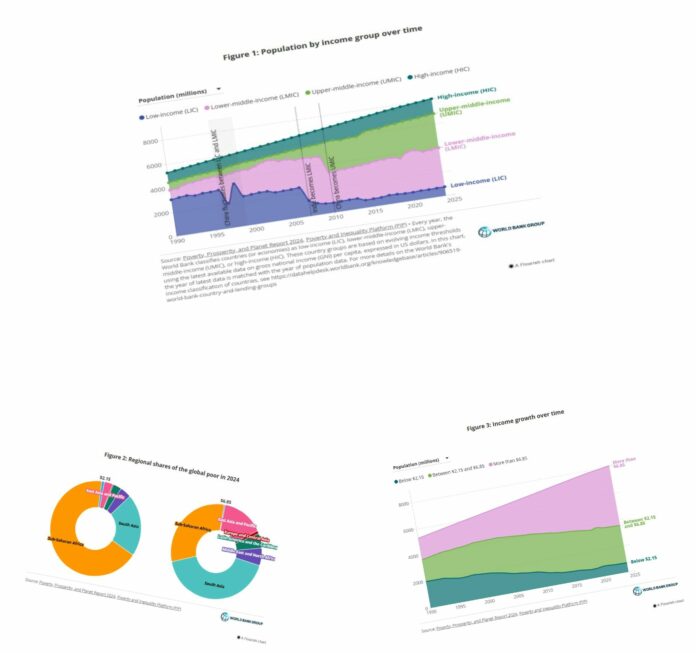- This is the third blog in a series about how countries can make progress on the interlinked objectives of poverty, shared prosperity and the livable planet. For more information on the topic, read the 2024 Poverty, Prosperity, Planet Report.
By Samuel Kofi Tetteh Baah, Henry Stemmler, Maria Eugenia Genoni and Christoph Lakner
In line with its new, expanded vision to create a world free of poverty on a livable planet, the World Bank has expanded its definition of poverty to reflect changing demographic patterns in the world. As part of its revamped corporate goals, the World Bank will now monitor poverty at a higher poverty line, typical of upper-middle-income countries, currently set at $6.85, in addition to the international poverty line of $2.15. Both poverty lines are expressed in 2017 purchasing power parity (PPP) dollars per person per day.
Starting with its dollar-a-day poverty line set in 1990, the World Bank has been monitoring extreme poverty using a poverty line that is consistent with the standards of poverty in the poorest countries. The dollar-a-day line has evolved over the years to $2.15, which, by definition, is the estimated minimum daily amount of money required in a typical low-income country to cover basic needs – usually food, shelter, and clothing.
Over the past decades, the demographic structure of the world has changed substantially. Between 1990 and 2024, the world’s population has increased by 2.8 billion, or more than 50 percent, to over 8 billion (Figure 1). In 1990, nearly 6 in every 10 people were living in low-income countries (Figure 1). Low-income countries were also home to more than 9 out of 10 of the world’s extreme poor. It therefore made a lot of sense for the Bank to set a poverty line reflecting the standards of poverty in the poorest countries.
Today, lower- and upper-middle-income countries account for more than three-quarters of the world’s population (Figure 1). Many countries, especially populous ones like China and India, have graduated from low-income to lower- or upper-middle-income status. Today’s low-income countries constitute only 9 percent of the world’s population. For middle-income countries, the extreme poverty line may be too low to provide an accurate depiction of poverty.
Because of these evolving conditions, the World Bank will be reporting as part of its vision indicators an additional headline poverty series using the upper-middle-income poverty of $6.85. With growing income levels, the definition of basic needs expands beyond food, clothing, and shelter and now also includes a healthy diet, good sanitation, internet connectivity, access to electricity, and education, among others (see here and here).
The $6.85 poverty line is an absolute poverty line that captures this expanded definition of poverty and helps present a more relevant picture of poverty in more regions. Figure 2 shows significant changes in the regional profile of global poverty when moving from $2.15 to $6.85. For example, the share of the global poor living in Sub-Saharan Africa almost halves from two-thirds to about a third, while it doubles from 21 percent to 42 percent in South Asia.
Figure 3 highlights how the global distribution of income or consumption has changed over the past few decades. In 1990, around one-third of the world’s population lived on less than 2.15 a day, another third between 2.15 a day and 6.85 a day, and the remaining one-third on more than $6.85 a day. Today, around one-half of the world’s population (56 percent) lives on more than $6.85 a day, while less than 9 percent lives on less than $2.15 a day, showcasing the significant progress that has already been made. The share of the world’s population between $2.15 and $6.85 has remained almost the same at one-third.
Looking at this progress in absolute numbers of people shows a somewhat different picture. Because of population growth, the number of people living on less than $6.85 a day globally has barely changed; namely, 3.7 billion in 1990 and 3.5 billion in 2024. Thus, the new focus on the $6.85 poverty line represents an enormous population, and a more urgent need to fight global poverty and build resilience in a world that is more susceptible to climatic and economic risks than a few years ago.
Notwithstanding the World Bank’s expanded definition of poverty, eradicating extreme poverty remains at the core of the World Bank’s mission. The World Bank is the custodian of Sustainable Development Goal (SDG) target 1.1., which is to eradicate extreme poverty everywhere by 2030. Currently, more people live in extreme poverty in middle-income countries than in low-income countries. Thus, tracking poverty using the international poverty line of $2.15 remains relevant both for low- and middle-income countries and it focuses on the most severe deprivations.
– The authors gratefully acknowledge financial support from the UK Government through the Data and Evidence for Tackling Extreme Poverty (DEEP) Research Program.





